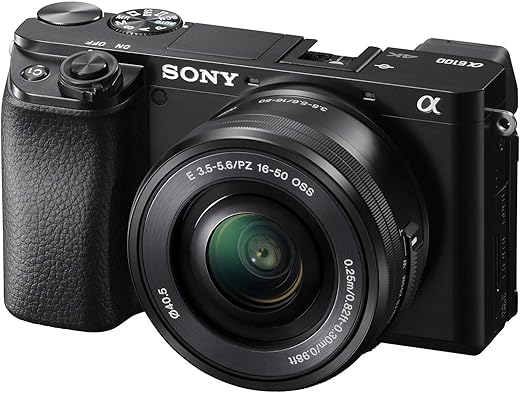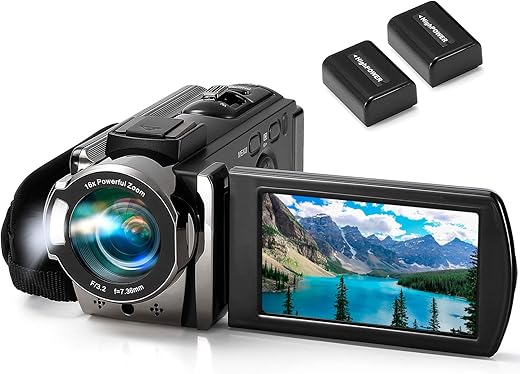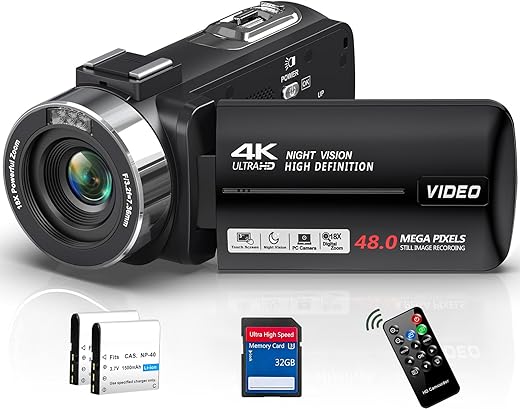In the realm of mirrorless cameras, the Sony A6100 and the Sony Alpha a6400 represent two compelling options that cater to both amateur photographers and seasoned professionals. While both models share a lineage and boast impressive specifications, they also embody distinct features and capabilities that may influence a photographer’s choice. In this comparison, I will explore the key differences and similarities between these two cameras, focusing on their performance, usability, and overall value, to help make an informed decision for potential users.
Creative Photography
The Sony Alpha A6100 Mirrorless Camera offers world-class performance with rapid autofocus at 0.02 seconds and 24.2MP resolution, making it ideal for capturing fast-moving subjects. Its 180-degree tiltable touchscreen and real-time Eye AF ensure you can effortlessly take stunning photos and videos, whether of humans or animals.
**Vlogging Excellence
The Sony Alpha a6400 Mirrorless Camera features a powerful 20.1MP sensor and exceptional autofocus, delivering fast and precise subject capture with continuous shooting of up to 11 frames per second. Its versatile 4K video capabilities and tiltable LCD make it an ideal choice for both professional filmmaking and vlogging.
Sony A6100 Camera
Sensor Resolution
24.2MP APS-C Exmor sensor
Autofocus System
425-phase/425-contrast detection AF points
Continuous Shooting Speed
Up to 11fps with AF/AE tracking
Video Recording Capabilities
Basic movie recording with mic
Display Type and Functionality
3″ tiltable touchscreen LCD
Sony Alpha a6400 Camera
Sensor Resolution
20.1MP stacked back illuminated 1″ Exmor RS CMOS sensor
Autofocus System
425-phase/425-contrast detection AF points
Continuous Shooting Speed
Up to 11fps with crisp, clear natural colors
Video Recording Capabilities
Multiple movie functions including time lapse and slow/quick motion
Display Type and Functionality
Tiltable LCD screen customizable for vlogging and professional filming
Sony A6100 Camera
Sony Alpha a6400 Camera
Sony A6100 Camera
Sony Alpha a6400 Camera
Comparison chart


Unique Selling Points (USPs)
Sony Alpha A6100:
- Affordability: Priced more competitively, making it a great entry-level option.
- Beginner-Friendly: Designed with easy-to-use features ideal for novice photographers.
- Battery Life: Better battery life for extended shooting sessions.
Sony Alpha a6400:
- Advanced Autofocus: Real-Time Eye Auto Focus excels for portrait and wildlife photography.
- Flip Screen: Perfect for vlogging and selfies with its fully articulating screen.
- Enhanced Burst Tracking: Improved capabilities for fast-moving subjects, making it suitable for sports photography.
Similarities
- Both models share a 24.2 MP APS-C sensor.
- Both come with a 16-50mm zoom lens.
- Both offer 4K video recording and have similar connectivity options.
- Comparable in weight and portability.
Pros and Cons
Sony Alpha A6100:
Pros:
- Excellent battery life.
- User-friendly interface for beginners.
- Lower price point.
Cons:
- Lacks advanced autofocus features of a6400.
- Fixed screen can be limiting for vloggers.
Sony Alpha a6400:
Pros:
- Superior autofocus capabilities, favored by professionals.
- Flip screen for flexible shooting angles.
- Solid build quality with weather resistance.
Cons:
- Higher price tag.
- Slightly shorter battery life compared to a6100.
Use-Cases
Sony Alpha A6100:
- Ideal for beginners or casual photographers seeking a straightforward camera.
- A great choice for travel photography, given its lightweight and compact design.
Sony Alpha a6400:
- Perfect for content creators and vloggers needing a reliable autofocus system.
- Suitable for advanced photographers looking for high-quality performance in various situations, including sports and action photography.
Conclusive Assessment
Determining a clear winner between the Sony Alpha A6100 and the a6400 depends largely on user needs. If you prioritize budget and ease of use, the Sony Alpha A6100 stands out as the better choice. However, if you require advanced features like superior autofocus and a versatile screen for dynamic shooting, the Sony Alpha a6400 emerges as the preferred option.
Final Summary
Both the Sony Alpha A6100 and a6400 are solid mirrorless camera options with distinct strengths. The A6100 offers a more accessible entry point for novice users who value battery life and simplicity. In contrast, the A6400 appeals to those who need enhanced autofocus technology and flexibility in their shooting configurations. Ultimately, your choice should align with your specific photographic needs and budget considerations.


Exploring Top Mirrorless Alternatives
Guidelines for Comparing Mirrorless Cameras
When considering a purchase in the mirrorless camera category, it’s essential to systematically evaluate the various models to make an informed decision. Below are general guidelines and key factors to consider when comparing products such as the Sony A6100 and the Sony Alpha a6400 cameras.
1. Image Quality
Sensor Type and Size
- Sensor Size: Full-frame sensors typically offer better low-light performance and dynamic range. APS-C sensors, like those in the A6100 and a6400, strike a good balance between size and performance.
- Resolution: Higher megapixel counts yield more detail, which is beneficial for large prints and cropping.
ISO Performance
- Low-light Performance: Assess how each model handles high ISO settings as it affects image noise.
- Dynamic Range: Evaluate the models’ capability to capture detail in shadows and highlights.
2. Autofocus System
Number of Autofocus Points
- More autofocus points can lead to better tracking of subjects, especially in fast-paced environments.
Focus Speed and Accuracy
- Assess the speed at which the camera can focus, especially in low lighting or challenging conditions.
Eye-detection AF
- Eye-detection features are critical for portrait photography, ensuring that subjects’ eyes remain sharp.
3. Video Capabilities
Video Resolution
- 4K Recording: Both cameras support 4K, but check for features like frame rates and bit rates that can affect quality.
Audio Input/Output
- Consider models that provide options for external microphones or headphone jacks for better sound quality.
In-body Stabilization
- Evaluate whether in-body stabilization is available, as it can improve video quality by reducing shakiness.
4. Ergonomics and Usability
Build Quality
- Materials: Look for cameras made from robust materials like magnesium alloy for durability.
Controls and Layout
- Assess the intuitiveness of placement of buttons, dials, and touchscreens.
Weight and Size
- Compact cameras are easier to carry, while larger ones may offer better handling and comfort.
5. Battery Life
- Compare battery life ratings for each model. Longer battery life is especially crucial for event photography where charging is not always feasible.
6. Lens Compatibility
Available Lens Ecosystem
- Ensure that a variety of lenses is compatible with the body to suit your photography needs.
Kit Lens Quality
- Check the quality of the included kit lens, if applicable, as it can affect overall experience.
7. Price and Value
Cost Comparison
- Analyze the price differences between models while taking into account the features they offer.
Warranty and Support
- Look into warranty options and customer support, as this can provide added peace of mind.
Essential Answers About Mirrorless Cameras
The main specifications that differ between the Sony Alpha A6100 and the a6400 are as follows:
- Autofocus System: The A6100 features a 425-point phase detection and 425 contrast detection autofocus system, whereas the a6400 offers a similar 425-point phase detection but enhances the accuracy with Real-Time Eye Autofocus for both humans and animals, making it more effective for portrait photography.
- Continuous Shooting Speed: The A6100 boasts a continuous shooting speed of up to 6 frames per second (fps), while the a6400 can achieve up to 11 fps with the mechanical shutter and 8 fps with the silent shooting mode, providing more versatility for capturing fast-moving subjects.
- Video Capabilities: Both cameras can shoot 4K video, but the a6400 has more advanced video features, including S-Log3 and S-Log2 profiles for better color grading in post-production.
- LCD Screen: The A6100 is equipped with a tiltable LCD screen, while the a6400 has a fully articulating touchscreen (flip-up) that is ideal for vlogging and selfies.
- Body Design and Build: The a6400 has a slightly more robust build with a magnesium alloy body, providing better durability and weather resistance compared to the A6100.
- Viewfinder and Screen Resolution: The a6400 features a higher resolution electronic viewfinder and LCD screen compared to the A6100, enhancing image clarity and overall usability.
- Battery Life: While both cameras use the same NP-FW50 battery, the a6400 typically offers better power efficiency, translating to longer battery life under certain shooting conditions.
These differences make the a6400 a more advanced option for enthusiasts and professionals, while the A6100 provides a great entry point for those new to mirrorless photography.









Super helpful article! I didn’t realize the A6400 had such better autofocusing.
Great comparison! I’ve been torn between these two for ages now. Thanks for the insights!
I love my A6100, but now I’m kinda jealous of the A6400 features. Decisions, decisions!
Can anyone share their experience with low light performance on both cameras?
Honestly, both look amazing! Which one do you think is better for vlogging?